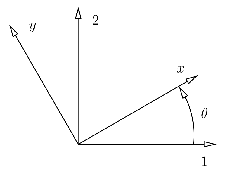
One common operation in classical laminate analysis is to rotate vectors, tensors and matrices. One summarizes here the operations one uses in the rest of this Chapter and in FeResPost. This rotation is represented in Figure II.1.3.
For such a rotation, the vectors and are expressed as a function of and as:
To simplify the notations, one introduces the symbols and . Also, one prefers to write the more general 3D version of the transformation:
| (II.1.1) |
The inverse relation corresponds to a rotation of angle and is obtained by changing the signs of the sinuses in the rotation matrix:
| (II.1.2) |
The expressions (II.1.1) and (II.1.2) can be used to transform the components of vectors. For example:
| (II.1.3) |
For the transformation of 2D tensors, the transformation matrix is used twice. For example, a Cauchy stress tensor is transformed as follows:
| (II.1.4) |
As the Cauchy stress tensor is symmetric, expression (II.1.4) is more conveniently written in a matricial form as follows:
| (II.1.5) |
The same expression applies to the components of the strain tensor, which is also symmetric:
However, unfortunately, the classical laminate analysis is universally written using angular shear components for the strain tensor:
Using the angular components, the matricial expression to be used for the rotation becomes:
| (II.1.6) |
An interesting aspect of the transformations (II.1.5) and (II.1.6) is that one can apply the transformation separately on sub-groups of components:
| (II.1.7) |
| (II.1.8) |
The relation has been written for the out-of-plane shear components of strain tensor. Note however, that the relation is the same for the out-of-plane shear components of Cauchy stress tensor.
This contributes to justify some of the simplifications of the classical laminate analysis; among others, the decoupling of in-plane and flexural deformation of the laminate on one hand from the out-of-plane shear on the other hand. The third direction is systematically neglected: . The inverse of relation (II.1.7) is obviously;
| (II.1.9) |
In order to simplify the notations, one introduces the following notations:
| (II.1.10) |
These matrices are not independent. For example:
The transformations of the components of strain tensor (II.1.8) and stress tensor (II.1.9) are then written:
Similarly, for the out-of-plane shear stresses and strains one writes the following relations: